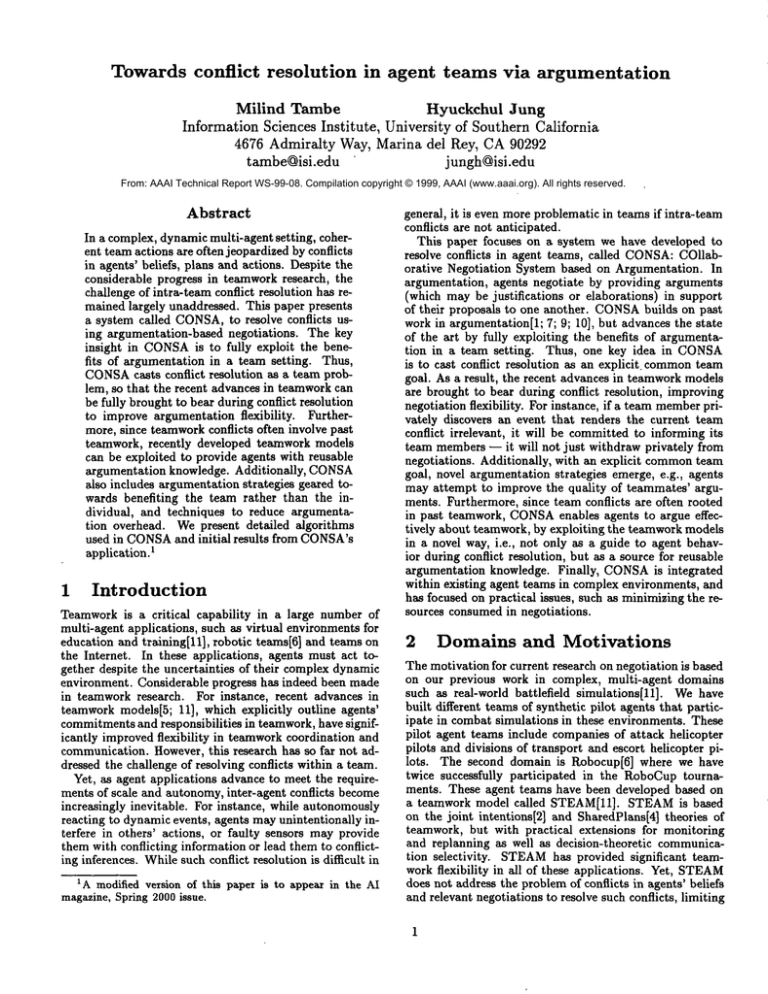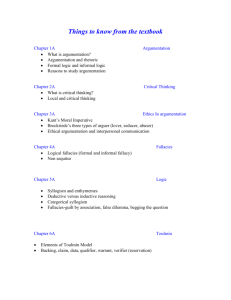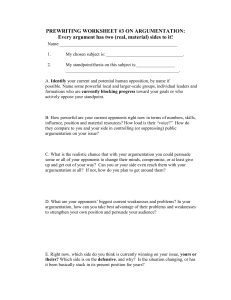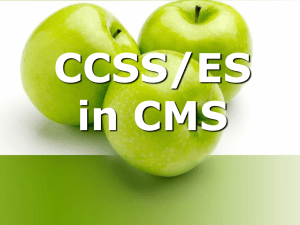
Towards conflict
resolution
in agent teams via argumentation
Milind Tambe
Hyuckchul Jung
InformationSciences Institute, University of SouthernCalifornia
4676 Admiralty Way, Marina del Rey, CA90292
tambe@isi.edu
jungh@isi.edu
From: AAAI Technical Report WS-99-08. Compilation copyright © 1999, AAAI (www.aaai.org). All rights reserved.
Abstract
In a complex, dynamic multi-agent setting, coherent team actions are often jeopardized by conflicts
in agents’ beliefs, plans and actions. Despite the
considerable progress in teamwork research, the
challenge of intra-team conflict resolution has remained largely unaddressed. This paper presents
a system called CONSA,
to resolve conflicts using argumentation-based negotiations. The key
insight in CONSA
is to fully exploit the benefits of argumentation in a team setting. Thus,
CONSA
casts conflict resolution as a team problem, so that the recent advances in teamworkcan
be fully brought to bear during conflict resolution
to improve argumentation flexibility.
Furthermore, since teamworkconflicts often involve past
teamwork, recently developed teamwork models
can be exploited to provide agents with reusable
argumentation knowledge. Additionally, CONSA
also includes argumentation strategies geared towards benefiting the team rather than the individual, and techniques to reduce argumentation overhead. Wepresent detailed algorithms
used in CONSA
and initial results from CONSA’s
1
application.
1
Introduction
Teamworkis a critical capability in a large number of
multi-agent applications, such as virtual environments for
education and training[ll],
robotic teams[6] and teams on
the Internet. In these applications, agents must act together despite the uncertainties of their complex dynamic
environment. Considerable progress has indeed been made
in teamwork research. For instance, recent advances in
teamwork models[5; 11], which explicitly outline agents’
commitmentsand responsibilities in teamwork, have significantly improved flexibility in teamworkcoordination and
communication. However, this research has so far not addressed the challenge of resolving conflicts within a team.
Yet, as agent applications advance to meet the requirements of scale and autonomy, inter-agent conflicts become
increasingly inevitable. For instance, while autonomously
reacting to dynamic events, agents mayunintentionally interfere in others’ actions, or faulty sensors may provide
them with conflicting information or lead them to conflicting inferences. Whilesuch conflict resolution is difficult in
1A modified version of this paper is to appear in the AI
magazine,Spring 2000issue.
general, it is even more problematic in teams if intra-team
conflicts are not anticipated.
This paper focuses on a system we have developed to
resolve conflicts in agent teams, called CONSA:COllaborative Negotiation System based on Argumentation. In
argumentation, agents negotiate by providing arguments
(which may be justifications
or elaborations) in support
of their proposals to one another. CONSA
builds on past
work in argumentation[l; 7; 9; 10], but advances the state
of the art by fully exploiting the benefits of argumentation in a team setting. Thus, one key idea in CONSA
is to cast conflict resolution as an explicit commonteam
goal. As a result, the recent advances in teamworkmodels
are brought to bear during conflict resolution, improving
negotiation flexibility. For instance, if a team memberprivately discovers an event that renders the current team
conflict irrelevant, it will be committedto informing its
team members-- it will not just withdraw privately from
negotiations. Additionally, with an explicit commonteam
goal, novel argumentation strategies emerge, e.g., agents
may attempt to improve the quality of teammates’ arguments. Furthermore, since team conflicts are often rooted
in past teamwork, CONSA
enables agents to argue effectively about teamwork, by exploiting the teamworkmodels
in a novel way, i.e., not only as a guide to agent behavior during conflict resolution, but as a source for reusable
argumentation knowledge. Finally, CONSA
is integrated
within existing agent teams in complex environments, and
has focused on practical issues, such as minimizing the resources consumedin negotiations.
2
Domains and Motivations
The motivation for current research on negotiation is based
on our previous work in complex, multi-agent domains
such as real-world battlefield simulations[Ill.
Wehave
built different teams of synthetic pilot agents that participate in combat simulations in these environments. These
pilot agent teams include companies of attack helicopter
pilots and divisions of transport and escort helicopter pilots. The second domain is Robocup[6] where we have
twice successfully participated in the ttoboCup tournaments. These agent teams have been developed based on
a teamwork model called STEAM[ll]. STEAMis based
on the joint intentions[2] and SharedPlans[4] theories of
teamwork, but with practical extensions for monitoring
and replanning as well as decision-theoretic
communication selectivity.
STEAM
has provided significant teamwork flexibility in all of these applications. Yet, STEAM
does not address the problemof conflicts in agents’ beliefs
and relevant negotiations to resolve such conflicts, limiting
teamworkflexibility in key instances. Wedescribe here just
a few key examples that outline some of the basic issues
for collaborative negotiations:
¯ The firing position case: Individual pilots in a helicopter team typically attack the enemy from firing
positions. These positions are planned by a commander agent, whoensures that they do not conflict, i.e.,
the positions are planned to be at least one kilometer apart from each other. However, despite careful
planning, individual pilots may autonomously react
to unexpected enemyvehicles, and end up in conflicting positions (e.g., muchless than 1 kmapart).
¯ The proceed case: In planning the positions described
above, the commanderpilot plans one position(e.g.
position to hide behind a small hill) per team member,
and communicates it to the relevant team membervia
radio. In one run, a messagewas lost due to radio interference, i.e., the commanderthought the position
was communicated, but a team member M1never received it. Thus, when the commanderasked the team
to proceed because it believed all of the positions were
successfully communicated, there was a conflict with
M1.
¯ The enemyposition case: Twoscout helicopter agents
may have conflicting beliefs about the closest enemy
unit seen. For instance, one scout may report completion of scouting and the closest enemyunit seen as
part of this report, while the second scout maysee an
even closer enemy unit than the one reported.
¯ Theballposition
case:In ourplayerteamin RoboCup
soccersimulation,
defenders
informeachotherif the
ballis closeby andhencea threat.
However,
theplayers’belief
ofthebali’s
threat
maydiffer,
leading
them
to haveconflicting
beliefs
aboutwhether
theballisa
threat.
In addressing such conflict resolution problems, our goal
is to avoid any specialized solutions, and focus instead on
a general approach that would be applicable to a wide
variety of conflicts.
3
Teamwork
Model
Before we discuss CONSA,
it is useful to briefly overview
teamwork models, particularly
the STEAM[ll] model,
since it is the basis of our team implementations. STEAM
consists of two components, both currently realized in the
Soar[81 architecture. The first is an enhanced agent architecture with explicit representation of team’s joint intentions, mutual beliefs and team goals. Figure 1 shows
an operator hierarchy (i.e., a reactive plan hierarchy) for
synthetic helicopter pilot developed using STEAM.Team
operators (reactive team plans), which explicitly express
team’s joint activities, are shownin ~, such as [Engage]. At
any time, one path through this hierarchy is active. This
active hierarchy of operators is the team’s joint intentions
(team operators) and individual intentions (individual
erators).
The second component of STEAMis the domain independent teamwork knowledge to enable individual agents’
flexible teamwork. Of particular importance here are two
of the classes of domain-independent actions. The first
[EXECUTE-MISSION ]
[ Fly-flight-p~n ]
[~r~eZrrlxol]
~’
(Engage]
Prepare-to 1
r
L retum-to-basej
lmploy
%~
"
R
MFsk Unmask ~.veapons cond~rog.~int
[Tmve,~.. ..........
Figure
I: Portion
of pilotoperator
hierarchy.
is coherence-preserving actions, derived from the joint intention theory[2]. These require agents to jointly activate
and terminate team operators, by establishing mutual beliefs in their initiation and termination; individual operators are executed without such mutual beliefs. The second class of domain-independent actions is maintenance
and repair actions, for re-planning and team reorganization. These actions require an explicit specification of the
dependencyrelationship of the joint intention on individual team members’ activities,
based on the notion of a
role. A role constrains a team memberMi to some suboperator opMi of the team operator lOP]. Three primitive
role-relationships (and their combinations) can currently
be specified in STEAM.An AND-combinationimplies that
the achievement of team operator requires achievement of
each one of the roles. An OR-combinationrequires success
in at least one role for the team operator to be achieved.
The role-dependency relationship states that an opMi depends on opMj.
4
Argument Representation
Evaluation
This section describes CONSA’s
underlying representation
and algorithms to evaluate arguments, which are embedded in a larger CONSA
process, discussed in the next section. CONSA’srepresentation of arguments is based on
Toulmin’s[12] argumentation pattern (henceforth TAP),
chosen for its generality. In a TAP, an argument consists
of the following elements: (i) claim: a conclusion whose
merit an agent seeks to establish. (ii) data: the facts that
are a foundation for the claim. (iii) warrants: the authority (e.g., a rule) for taking the step from the data to the
claim. (iv) qualifications: degree of force which conferred
on the claim based on the data and warrant.
In CONSA,claims are agents’ individual or mutual beliefs. During argumentation, these claims form the proposals, with the supporting TAPas the argument for the
proposal. For example, in RoboCupsoccer, a claim (proposal) may be that "the ball is a threat," supported by
data that "the ball is 30 meters from own goal," and a
warrant that "if the soccer ball is within 35 meters of own
goal, then it is very likely a threat." In CONSA,
the data
mayitself be another claim (belief), with its ownsupporting TAP, so that a recursive tree of TAPstructure may
emerge in support of a claim. Finally, in CONSA,the
qualifications on claims determine the strengths of arguments. Currently, claims have qualitative strengths: high,
medium and low. Thus, a strong warrant and data will
lead to a "high" strength for the claim.
2
Whenan agent sends a proposal to its team, team members must determine if their ownbeliefs conflict with the
proposal. Figure 2 presents CONSA’salgorithm to make
this determination. The input is a proposed TAPtree O,
which forms the proposal (claim), with supporting arguments. The output is a set ft of tuples ({reject(claimi)
accept(claimi) }, justification). Here, a reject tuple implies
an agent’s conflict with the claim~ E O, while an accept
tuple implies an improved justification in support of the
claim. The justifications consist of TAPs. If ~ is empty,
then no conflicts or improvements are found.
In the algorithm, step 1 ch~cks the input TAPtree O
for conflicts with the agent’s own claims. If a conflict
is found, step 2 compares the strengths of the conflicting claims, rejecting the other agent’s claim if ownclaim is
found stronger. Step 3 now compares the input claims from
O for coincidence or agreement. For simplicity, this algorithm assumes a single coincidence. If coincidence is found,
then the supports of coincident claims are compared, to determine the stronger support. If one is found, it is added
to ft. Whenno coincidence or conflict is found in O itself,
CONSA
will not immediately accept O. Since leaf nodes in
O may hold undesirable implications, CONSAderives implications from e(step 4). While in general checking undesirable implications is difficult, CONSA
currently executes
one iteration of such derivations, checking for conflict or
coincidence
andadding
theresult
to ft.
Evaluate-proposal(Input:
TAP-tree
O; Output:
G)
forallclaims
aiinTAP-tree
O do:
I. Inparallel,
{ Check
aiforconflict
withownclaims;
Ifa~conflicts
withownclaim
flj,
addtuple
(a~,3#)
toconflict-set
CS;
2. Foralltuples
(a~,3#)
E CS,starting
fromtuple
withlowest
ai E 0 do:
{ Compare-strengths(a/,/~j);
If 135 is stronger, add(reject(cri),3j) to f~;
3. In parallel, for all claims ai in TAP-treeO do:
{ Checkai for coincidence with ownbeliefs;
If coincidence with ownclaim 3i,
{ Compare-strertgths(support(c~i ), support(~
If support(3i) is stronger,
add (accept(ai,support(~i)) to n; } }
4. If f~ is empty,checkderivations of leaf claims in O;
5. Outputf~; if f/is empty,no conflicts or coincidencefound.
Figure 2: CONSA’salgorithm for evaluating proposal.
To determine the strengths of claim in the comparestrengths procedure in Figure 2, CONSA
relies on the supporting TAP structure.
Given that the TAP structure
can itself be recursive, claim strengths are evaluated recursively. For leaf-level claims, evidential rules are used.
Here, CONSA
exploits the benefits of argumentation in a
team setting, by relying on the following rules of evidence:
assertions from a team memberregarding its own role and
capability are judged to provide high-strength claims.
5
CONSA Approach
Figure 3 presents the overall CONSA
negotiation process.
Step 1 is a proposal generated by a team member. Steps
2, 3 and 4 are the opening, argumentation and termination stages of CONSA’s
negotiation. In the opening stage,
agents agree to jointly resolve the current conflict. In the
argumentation stage, they cycle through proposals and
counter-proposals, terminating arguments in the termination phase.
1. A team memberMi generates a proposal a.
2. Openingstage:
(a) A team memberMj detects a conflict with
(b) If Mjbelieves joint action not beneficial to resolving
conflict,
terminate,
return;
withteammembers
to estab(c)ElseMj communicates
lishteazn
operator
toresolve
current
conflict.
3. Argumentation stage
may
(a)Any memberMk in thecurrentteamoperator
generate
proposal
toresolve
conflict;
evaluate-proposal
(seeFigure
(b)Otherteammembers
2).
found,
accept
theproposal
(c)Ifnoconflict/coincidence
andgotostep4;
(d)Elseifproposal
found
toconflict/coincide;
continue
axgumentif cost-benefit-wise useful, else accept the
proposal and goto step 4:
4. Closing stage
(a) If suggested proposal accepted, then terminate
conflict-resolution team operator;
(b) Else if the conflict resolution found unachievableor
irrelevant, terminate conllict-resolution team operator;
Figure 3: Three stages of ar,um,’ntation
in CONSA.
Opening and Closing Stagt,s:
lu CONSA’sopening
stage, the conflict detection st,.p (2-a) requires it to address two different types of coallicl.~. In particular, based
on the description of the teamw,,rk model(Section 3), conflicts can be of two types: (1) "i;.am members may have
conflicting beliefs about joint ly init iating or terminating a
team operator, e.g., one agen! h~,liovos the team operator
must be terminated, while the t,I ht,r believes it cannot be
terminated; or (2) Agents CXCClltillg individual operators
mayunintentionally conllic! wit It oach other’s role performance. Thus, in the exatnph~s from Section 2, the "firing
position case" is a type 2 conflict, but the rest are type 1
conflicts. To detect a type 1 conflict, an agent must evaluate proposals sent by their teammatesto jointly initiate
or terminate team activities,
detected via the Evaluateproposal algorithm in Figure 2. In contrast, to detect
type 2 conflicts, CONSA
uses role constraints, that explicitly specify the maintenance goals for the successful performance of the role. For instance, in the firing position
case, the lateral-range (distance) between Mj (the agent
performing this role) and any other teammate must be at
least one kilometer.
Having detected a conflict in Step 2-a, we temporarily skip over step 2-b to focus on step 2-c. Here, a team
3
memberMj, who has detected a conflict, initiates establishment of a team operator to resolve the current conflict.
If the conflict is of type 1, Mj initiates the establishment
of resolve-joint-conflict as a team operator, involving the
entire team from the original joint activity. If the conflict
is of type 2, Mj initiates the establishment of resolve-role.
conflict as a team operator, but the involved team here
is only Mj and the agent that caused a conflict for Mj’s
role. For instance, in the firing position case, resolve-roleconflict is established as a team operator between Mj and
Mk(the agent that caused the role conflict).
By casting conflict-resolution itself as a team operator,
all of STEAM’s
flexible teamworkcapabilities are brought
to bear, to guide agents’ behavior during conflict resolution. For instance, agents jointly establish the conflictresolution team operators, using protocols that ensure synchronization and agreement among team members. In particular, teammates maydisagree about the existence of the
conflict, or they maybe unable to negotiate if they are performing another higher priority task. However, by using
a team operator for conflict resolution, an agent Mj begins negotiations only after ensuring its teammates agree
to and are able to engage in negotiations. Furthermore,
STEAM’sreasoning about commitments leads team members to behave responsibly towards each other. If a dynamic event causes a team memberto privately discover
that their conflict is resolved or unresolvable or irrelevant,
it will be committed to makethis mutually believed in the
team. A team member cannot just on its own drop out
from participation in the conflict resolution. The utility
of such flexibility can be seen in the firing position case.
If a team membersees enemy vehicles approaching, it will
terminate the current on-going negotiations, but do so responsibly while informing teammates of the situation.
Argumentation Stage: The argumentation stage involves an agent (sender) making a proposal to the agentteam (receiver) with an attached justification (argument).
The receivers evaluate the proposal taking the justification
into account, and either accept or refute it. If refuting the
proposal, a receiver may send back a counter-proposal to
the team, who may continue this cycle of proposals and
counter-proposals. Refutation may be done via rebutting
or undercutting[9]. Briefly, rebutting refutes the teammate’s claim (proposal) directly, with somejustifications.
In contrast, undercutting attacks the justification provided
with the proposal, rather than the proposal itself.
In this argumentation stage, the teamworksetting provides two key novel ideas. First, it enables and requires a
third strategy in addition to rebutting and undercutting,
which we call "improve support." In particular, an agent
receiving a proposal from its team membermay accept the
proposal, but mayhave a better justification for the proposal than the one offered by the sender. For instance, in
the "enemyposition" case from Section 2, the second scout
detected a closer enemy unit. The second scout agrees
with the top-level claim that the scouting is completed,
but it offers a higher quality solution about the closer enemy unit, which allows the helicopter team’s performance
to improve. It is to enable this "improve-support" strategy
that the Evaluate-proposal algorithm (Fig 2) checks for
claim coincidence.
Second, teamwork models provide reusable argumenta-
tion knowledge. In particular, team conflicts are sometimes rooted in past teamwork, as for instance in the proceed case. To argue effectively about teamwork, agents
must be knowledgeable about teamwork. Here, STEAM
provides general, reusable warrants for constructing TAPs.
For instance, the warrants shown below, extracted from
STEAM’srole relationships,
are employed in CONSA.
Here, warrant wl states that if a team operator r is an
AND-combination, and all of its roles are not achieved,
then the team operator is not achieved, w2 is a variation for an OR-combination and w3 is that for an ANDcombination.
t ~1: Team-Operator(r) A AND-combination(r}A -~ Allroles-fulfilled(r) --, -- achieved(r)
¯ w2: Team-Operator(r) A OR-combination(r) ^ -~
roles-unachievable(r) ~ -- unachievable(r)
¯ w3: Team-Operator(r) A AND-combination(r) A
roles-fulfilled(r) ---, achieved(T)
Real-time,
Efficient
Argumentation: There are
three techniques used in CONSA
to reduce resources utilized in argumentation and enhance its real-time performance (shown in steps 2-c and 3-d of Figure 3). One
technique is decision-theoretic reasoning of the cost-benefit
analysis of argumentation. For instance, in the "ball position case" in Section 2, the cost of arguing may outweigh
the benefits (e.g., the ball maybe shot into the goal by the
time the defenders complete their negotiations). Therefore, an agent will not negotiate with teammates even
though it detects a conflict in the teammates’ proposal.
The second technique is ordering of arguments. If there are
multiple arguments applicable, CONSA
will communicate
the strongest first, in order to speed up the argumentation
process. CONSA
also uses pruning (see below) to avoid
communication of commonlyheld warrants.
Detailed
Example of CONS.&application:
For a
detailed example of CONSA’s
application, we take the simple "proceed case" from Section 2. Figure 4 shows the initial warrants and claims that are mutually known by the
pilot agent team (of five agents), r is the current team
operator, an AND-combination. The initial proposal is
generated by the commanderagent (Step 1 of Figure 3)
suggest termination of the team operator r. This proposal
is a3 ~= a2, where a3 is the claim "achieved(v)" and
stands for a justification.
=~Mutually believed waxrants: wl, w2, w3 and w4: -~Rolefulfilled(self) --, -,All-roles-fulfilled(r)
=:.Commaatder
pilot agent’s initial claims: claim a2: All-roles.
fulfilled(r), claim 3’1: AND-combination(r)
=~Pflot agent Ml’s initial claims: claim /~4: -. Role-fulfilled
(self), claim 3"1: AND-combination(r)
Figure 4: Initial state: Commanderbelieves all-rolesfulfilled, M1believes ownrole not fulfilled.
M1evaluates the proposal from the commanderagent to
detect conflicts (step 2-a of Figure 3). During this evaluation, using the Evaluate-proposal algorithm from Figure
2, no direct conflicts are found (steps 1 through 4 of Figure
2). However, deriving implication of a2 leads to "P~lefulfilled(self)",
which conflicts with j34, Ml’s ownbelief.
However, /34 is evaluated to be stronger, as M1is an expert in its own role. M1next uses w4 and ~1 to construct
an argument: --~3 ¢:: -~2 ¢:: 84. (Warrants wl and w4
are pruned.) Essentially, M1informs the commanderagent
that it disagrees that the team operator is achieved, since
its ownrole is not fulfilled. Since this is a type 1 conflict,
the argument from M1is communicated to the entire team
of pilot agents. This causes all members(including M1)
establish a team operator (resolve-joint-conflict);
the team
has thus entered the argumentation stage of CONSA.In
this case, since/34 is in the area of expertise of M1,the commander (and other team members) evaluate 84 to have
high strength and accept it. They subsequently also accept
-~3 and -~2 based on the support offered by f14. Thus,
the proceed case is resolved by the commanderaccepting
Ml’s assertion, and it communicates this acceptance to
teammates.
6
Preliminary
Evaluation
CONSA
is currently realized in the Soar architecture in
109 rules. In the following we attempt a preliminary qualitative evaluation of CONSA.Our implementation has enabled agents to negotiate to resolve conflicts in all the cases
from Section 2, with the following results:
¯ Firing position case: An agent detects a conflict in
its firing position due to its role-constraint violation
(one kilometer lateral range). It then establishes
team operator (with the teammate that violates the
role constraint) to resolve role conflict. It generates
proposal to suggest an equidistant moveby each agent
(500 meters) to meet the lateral range role constraint.
This proposal is accepted by the second agent. (However, if the second agent can not move, it rejects this
proposal, causing the first agent to move1 kmon its
own.)
¯ Proceed case: As discussed previously, M1persuades
teammates that the current team activity
is not
achieved.
¯ Enemy position case: The second scout finds an
"improve-support" argument to inform the team that
it has better support (i.e., a higher quality solution),
in the form of closer-range enemythat it spotted.
¯ Ball position case: As the cost of negotiation exceeds
the likely benefits, agents avoid negotiations, and act
based on own (divergent) beliefs.
Wealso attempted to test CONSA’s
flexibility by creating some surprise variations of the above cases.
¯ proceed-l: The role relationship for the team operator r was changed from AND-combination to ORcombination. Here, despite team member Ml’s role
not being fulfilled, M1did not detect a conflict, and
no arguments were generated. This is correct, since
an OR-combination does not require all roles to be
fulfilled.
¯ proceed-2: Wegave one pilot agent (M1), two arguments to attack the commander’s proposal, one based
on own role, and one based on another teammate M3’s
role. Here, M1correctly selected the stronger argument based on own role to communicate first to the
team.
¯ firing-position-l:
Whenthe pilots established the
resolve-role-conflict team operator to resolve firing position conflicts, enemyvehicles were suddenly placed
close by to them. The pilot whonoticed these vehicles
first, terminated the conflict-resolution team operator
as it was irrelevant, and informed its teammate.
¯ firing-position-2: In a similar situation as above, we
had one helicopter destroyed. The second terminated
the negotiation, as this team operator had become
unachievable.
7
Related
Work
Previous work in argumentation-based negotiation has often assumed non-cooperative agents. For instance, [7; 10]
uses several argument types borrowed from human argumentation in non-cooperative situations, e.g., threat,
promise of a future reward, and appeal to self interest.
An example from [7] is negotiation among two robots on
Mars. Here, to persuade a robot R2, a robot R1 threatens
it (R2) that R1 will break l:t2’s camera lens or antenna,
if R2 does not comply. Such arguments appear inappropriate in team settings, e.g., if ttl and R2 are a team,
and if R1 carries out its threat, then it will have a teammate (R2) without a lens or antenna. Other explicitly
non-collaborative argumentation work appears in the legal
domain, e.g., DART[3], which is also based on Toulmin’s
representation schema. In contrast, [9] does not explicitly assume collaborativeness or non-collaborativeness in
agents.
CONSA
differs from this work in its explicit exploitation
of the team setting in argumentation. As seen earlier, it exploits teamworkmodels: (i) to guide flexible agent behavior in negotiation and (ii) as a source of reusable argumentation knowledge. It also adds argumentation strategies so
agents can collaboratively improve each other’s arguments.
Also, CONSA
includes techniques to avoid high overheads
of negotiations.
Chu-Carroll and Carberry’s work in argumentation does
assume collaborativeness
on part of the participating
agents[l]. While they use SharedPlans[4] in negotiations,
they appear to treat SharedPlans as a data-structure,
rather than a teamwork model. Thus, unlike CONSA,
they do not use SharedPlans either for prescribing agents’
behaviors in negotiations, or as source of reusable argumentation knowledge.
8
Summary and Future
Work
Multi-agent teamworkin diverse applications ranging from
planning, design, education and training, faces the problems of conflicts in agents’ beliefs, plans and actions. Collaborative negotiation is thus a fundamental componentof
teamwork. To address the problem, this paper describes
an implemented system called CONSAfor collaborative
negotiation via argumentation. While CONSAbuilds on
previous work in argumentation, it advances the state of
the art via the following key ideas: (i) CONSA
casts conflict resolution as a team problem, bringing to bear some
of the recent advances in flexible teamworkto improve the
flexibility of agent behavior in conflict resolution; (ii) Since
team conflicts are often about past teamwork, CONSA
ex-
ploits teamwork models to provide agents with reusable
argumentation knowledge; (iii) CONSA
focuses on collaborative argumentation strategies such as improve-support;
(iv) As an implemented system in a dynamic environment,
CONSA
uses a decision theoretic approach, argument ordering and pruning to reduce the cost of negotiation. We
have presented detailed algorithms and initial results from
CONSA’simplementation. Areas of future work include
understanding CONSA’simplications for argumentation
in self-interested agents.
Acknowledgements
This research was sponsored
no. F49620-97-1-0501, and in
the Boeing Corp. We thank
portions of the CONSA
system
in part by AFOSRcontract
part by a subcontract from
Zhun Qiu who implemented
described in this paper.
References
[1] J. Chu-Carroll and S. Carberry. Generating information sharing subdialogues in expert-user consulation.
In Proceedings of international joint conference on Artificial Intelligence, 1995.
[2] P. R. Cohen and H. J. Levesque. Teamwork. Nous,
35, 1991.
[3] K. Freeman and A. Farley. Towasds formalizing dialectical argumentation. In Proceedings of the Conference on Cognitive Science Society, 1993.
[4] B. Grosz. Collaborating systems. A1 magazine, 17(2),
1996.
[5] N. Jennings. Controlling cooperative problem solving in industrial multi-agent systems using joint intentions. Artificial Intelligence, 75, 1995.
[6] H. Kitano, M. Asa~la, Y. Kuniyoshi, I. Noda, and
E. Osawa. Robocup: The robot world cup initiative.
In Proceedingsof the first international conference on
autonomous agents, 1997.
[7] S. Kraus, K. Sycnra, and A. Evenehik. Reaching
agreements through argumentation: a logical model
and implementation. Artificial Intelligence, 104:1-70,
1998.
[8] A. Newell. Unified Theories of Cognition. Harvard
Univ. Press, Cambridge, Mass., 1990.
S.
Parsons and N. R. Jennings. Negotiation through
[9]
argumentation -- a preliminary report. In Proceedings of the International Conference on Multi-agent
Systems, 1996.
[10] K. Sycara. Persuasive argumentation in negotiation.
Theory and Decision, 28(3), 1990.
[11] M. Tambe. Towards flexible teamwork. Journal of Artificial Intelligence Research (JAIR), 7:83-124, 1997.
[12] S. Toulmin. The uses of argument. Cambridge Univ
Press, London, 1958.
6






